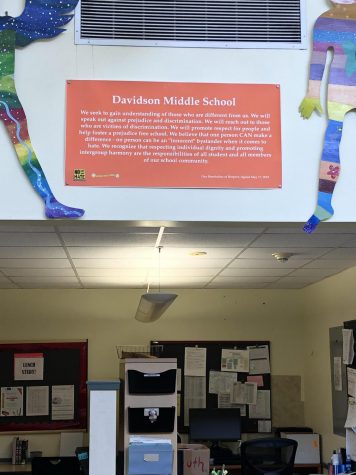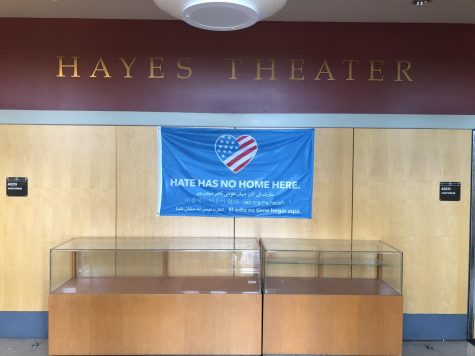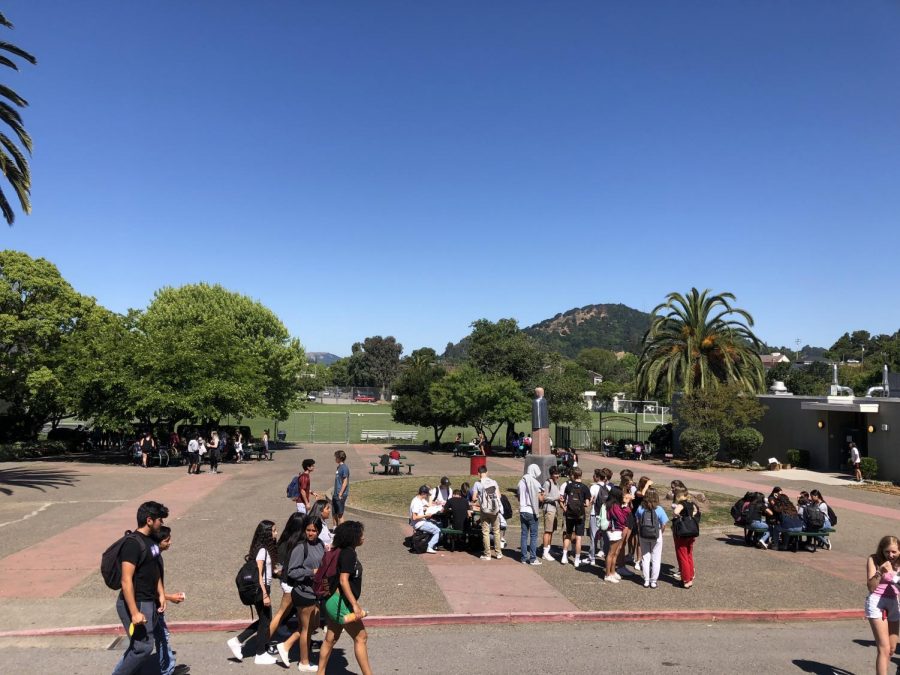Why We Sit at Different Tables: Self-Segregation at San Rafael High School
June 14, 2019
“At San Rafael High School, we celebrate diversity.”
This is a common phrase you are likely to hear from SRHS representatives. However, the moment you step on campus, the racial divide is evident. At lunch, during class, between classes, even in the hallways. The groups that gather are segregated by race, and with few exceptions, it is always self inflicted.
On the edge of Marin County lies San Rafael High School, a school that differs from the rest in the county. Unlike the other high schools, SRHS has a significantly diverse population with 56% of students being Latinx, 34.5% being white, and 9.5% being Asian, Filipino, Pacific Islander, black, Indian American, or biracial. This demographic differs from the other predominantly white high schools within the county.
With this diverse population comes obstacles, and we made it our mission to understand not only why we self segregate, but where this issue arises from, and what action is being taken to find solutions.
“[Races] don’t interact. They’re very distant from one another,” Susie Galindo, a sophomore at SRHS, told us. “People who come to this school think that it is normal and okay for [self segregation] to happen.” Susie Galindo has had multiple negative experiences related to race during school hours, often stemming from being latina.
For Susie, the way in which races interact has deeply affected her day-to-day life. Because of interactions she has encountered with her peers, Susie found it necessary to switch schools in middle school. Susie went from Davidson Middle School to Venetia Valley where she said the administration actually paid close attention to race relations and uniting every student by not ignoring their racial differences, but rather by talking about their differences.

At SRHS, while the self-segregation is prominent, it doesn’t appear to come from hatred. Often, decent students are simply stuck in patterns that they were taught. By the time students enroll at SRHS, they already have subconscious notions about race.
“I don’t think it is as easy as people liking or disliking people because of their ethnicity. It has to do with people you are surrounded with and how that plays out over your 12 years in the system,” Ms. Thurston, an English teacher at SRHS, told us. “My experience at this school is that, for the most part, everyone here is trying very hard to be a good person and wants to be a good person.”
“It might not be intentional, but the effect is just as extreme and harmful,” Ms. Padayachee, a history and Link Crew leadership teacher here at SRHS, told us. Ms. Padayachee is known for her hands on and progressive approach when it comes to tackling difficult issues such as race relations.
Student experience on a social level is often directly related to students’ ability to succeed academically. Students feel more comfortable when they are accepted by their peers. Small microaggressions about race and ethnicity build up and leave a lasting impact. When students don’t feel comfortable around their classmates, they are less likely to participate in class discussions, especially when it relates to emotional topics.
Students and teachers are beginning to see change, yet many remain skeptical due to the lack of open conversations.
“You can talk about it, but you can’t really talk about it one on one. It’s just gonna go in one ear and out the other. Nobody is actually gonna feel it. So I wouldn’t actually talk about my race problems,” said Shivali Sangar, a junior at SRHS, who is of Indian descent.
“You can try, and once you’ve tried enough, you just give up and stop trying,” Susie went on to tell us. “Right now, I don’t care anymore.”
Susie, Shivali, Ms. Padayachee, and other members of the school community make it clear: race-related issues impact student interaction, which affects their day-to-day lives, from self-image, to their hopes for the future. Many students see their hope and faith in solutions to this school challenge fading.
A hopeless feeling is common. Frustration amongst students and teachers concerning the administration was noticeable throughout many of the interviews. Some felt that the administration did not do enough to aid to race related issues, and others felt the administration failed to create a place they could go to in the instance of a race related issue.
“They’ll [admin] make it seem like they care in a way, but if they really did, they would do more about it,” Susie told us.
“They’ll [admin] throw up a few posters and be like, ‘Ahh stop racism.’ There are days or weeks where they’re just like ‘all inclusive’ or whatever… their normal bull****. They try, but there is not much they can do,” JC Blecka, a senior at SRHS, told us.
“I have never seen admin do anything about anything race related,” Lily Waite, a senior at SRHS, said.
We asked Royce Hughes, an African-American school supervisor at SRHS, if the school talked about race enough. Royce said, “Absolutely not, I haven’t really seen this being a main topic. With everything going on in the world I do feel as though students need to be informed.”
Mr. Butler, a white P.E. teacher here at SRHS, told us, “For me to sit here and say there’s no issues would be totally ignorant.” Being part of the physical education department allows Mr. Butler to interact with almost every SRHS student.
However, when speaking with certain teachers, some felt that administration did quite a lot for the school concerning race related issues. “It’s a very complex issue, but I think the school does a really good job addressing problems of diversity and cultural differences,” Mr. Ortiz, one of the few latino teachers on campus, told us.
“They have brought in the ADL (Anti Defamation League). They have brought in professional development. The administration has done quite a lot about it… They are trying to do their best,” Mr. Baker, a math teacher at SRHS, told us.

It is arguable that the frustration some of SRHS students and teachers feel towards the administration roots from the fact that our administration reports to a higher authority. Above the SRHS administration sits the district office.
“I think [the district] is too far removed from the actual people. There is too much ‘distance’ between the actual humans and the way that they’re reflected in data,” one teacher told us. As an ELD teacher who takes in newly immigrated students week to week, this teacher works closely with a population of SRHS that is often marginalized by a system such as high school.
The district does not have the same emotional or even physical connection to students on any campus. Teachers and administrators on campus observe students during class and breaks. They know students’ names and what they like to do in their free time. Other than the instance of involvement for behavioral issues, the district does not interact with students. They are very numbers oriented.
It is the school’s job to create a level playing field for students, and in order to do so, they often must go to the district. There, goals for all schools are set as well as plans to achieve them. While the administration should be the linkage between students and the district, this link seems to be missing.
“No, I have never heard a word from the district. They’re kinda MIA,” JC Blecka said.
There are viable solutions to this problem, however it cannot be left to one high school administration to solve a problem so deeply ingrained in our systems. We are all part of this system and have the ability to ignite change. These preconceived notions begin at a young age and it will take much more than a single conversation to repair the damage.
Self-segregation is not just a San Rafael High School specific issue, it’s not even a high school specific issue. Race related issues arise everywhere across our nation and the world. Hundreds of years of history have built the society we are living in today and directly influence each individual’s experience. High school is hard enough on its own and adding racial tensions into the mix doesn’t make it any easier. It is, however, a necessary conversation that must take place in all schools, especially in demographically diverse ones like SRHS.
Vice Principal Dr. Heredia, as well as the principal, Mr. Dennis, were willing to comment on these topics.
Dr. Heredia is the only second level Latinx staff member in the district, who wrote her dissertation on “leadership through the lens of equity and race and how it affects us.” She spoke with us about institutionalized racism within the educational system.
She explained that our 300 year old educational system has not evolved the same way humans and society have. We still do not have equality in the educational system because it was not designed with equity and, “we haven’t changed the actual institutional structure,” Heredia told us.
Ms. Heredia noted, “we have some diversity but I still feel that we are not integrated.” She contributed this to the way elementary schools and the city is designed. Once students enter SRHS, they usually stick to “habit and comfort” and stay with the same group of people.
“I cannot ignore race,” Mr. Dennis told us. Being the principal at SRHS, Mr. Dennis has witnessed multiple instances over the years of racial disputes. However, the main problem related to race at SRHS is not overt racism, but rather inequalities between the many races.
The experience of a white student at SRHS is likely to differ greatly from the experience of a Latinx student, which is likely to differ greatly from the experience of an Asian student, and so on.
The way in which institutions such as schools and college testing impact different people of different races, which parent voices are heard by schools, and the way in which housing is set up and sold in Marin are all examples of certain inequalities different races may face.
Jose de La Rosa has spoken with many different parents because of his role as the SRHS athletic director. When speaking about how white parents are the main voices for this school, Jose said, “[It] is going to be more of the school they want it to be because they are basically steering the boat. They are going to get their voices heard because they are speaking out about it versus parents who don’t because they are scared of the language barrier.”
While there is technically nothing stopping other parents from becoming involved, it would be ignorant to ignore the barriers and fears they may face. Even if white parents advocate for Latinx, Asian, Filipino, Pacific Islander, black, Indian American, and biracial students, they will never have a first person understanding of that student’s experience. For this reason, expanding the diversity of parent voices that are heard is necessary for the advocation of all students.
“You can see how the patterns of race relations in San Rafael plays itself out in the high school,” Principal Dennis commented on the segregation of the city.
“We’re battling a really deep system. These systems, the structures that we have in place, lead to the neighborhoods being segregated which create this whole path,” said Jason Richardson, the principal of Glenwood, an elementary school in the San Rafael City School district.
The San Rafael City School district contains 7 elementary schools, each serving a specific neighborhood. Elementary school is the place where students spend most of their time, at their youngest and most impressionable age. In kindergarten through 5th grade, not only are they learning how to read and write, add up numbers, and wondering why the sky is blue, but they are learning social skills everyday.
The district’s neighborhoods are divided by race. Because each neighborhood is racially segregated, the elementary schools are segregated by proxy.
“There are beliefs that because we educate second language learners, that in some way the curriculum is brought down. That rather than teaching to the top, we’re teaching to the bottom,” Karrie Coulter told us when speaking on white parents’ most common reasons for pulling their children from San Pedro Elementary School after pre-kindergarten. Coulter is the assistant principal of San Pedro Elementary School which is made up of 98% Latinx students.
This argument that white students will be held back by students learning English is open to question. In kindergarten, while children are learning the ‘basics’, they are primarily learning how to correctly function as human beings. They learn to say please, thank you, may I, and how to help a friend. When they hurt someone they learn to apologize, and most of all, they learn how to interact.
Society has a plan for preparing youth for the real world, and this plan is meant to play out in the elementary schools, yet the elementary schools look nothing like the real world. The world is filled with different races, ethnicities, cultures, and much more. Children are placed in schools surrounded only by children who look like them and are growing up in the same neighborhood, there are valuable opportunities being missed.
As one would expect, these segregated neighborhoods become a foundation for race relations later in student’s lives. Neighborhoods decide which elementary school students will attend, resulting in middle school being the first time that students from different elementary schools mix.
At Davidson Middle School, students of different races from different elementary schools begin attending classes together for the first time in 6 years. While we may complain about the SRHS administration’s shortcomings, they cannot solve a problem that began in kindergarten.
As we spoke with Susie Gilando more, the topic of Davidson Middle School came up. Most of the students that attend SRHS come from Davidson, however Susie is different. “I left for that reason,” she told us when speaking about leaving Davidson due to the way in which races interacted.
A person’s skin is apart of every single human’s identity and it should be recognized, not dismissed. This goes for the discussion of race as well. Discussions about race need to happen in order for every student to feel validated. At SRHS, many students of color don’t feel validated. Instead, they feel ignored.
Students need to feel accepted enough to talk about race, identity, and other issues. When children or teenagers do not feel accepted within their own community and school, they will often feel uncomfortable starting an important conversation such as this one. Many don’t think that this, race relations, is an important conversation because they were never raised to think that way.
“We do not know how to talk about it here. It is a very tense, uncomfortable, awkward conversation to have at this school,” Ms. Padayachee told us.
Ms. Padayachee and her students in the Link Crew class put together an evening in the school’s theater that would explain the many hardships students face when immigrating to the United States. Students from different countries, who spoke different dialects, were given a platform and spoke about their experiences.
During many of our interviews, this evening was brought up. Many students were offered extra credit to go, and with a large student body in attendance, the stories of many students immigrants were heard by the SRHS community. This event was the first of its kind at SRHS. However with all the praise, many, including Ms. Padayachee herself, agreed that this night alone was not enough, but rather the beginning.
“One conversation in a class is not going to move the needle where I believe it needs to go,” Ms. Brett, a history teacher and history department chair at SRHS told us.
“You will see teachers trying to make a change, but they only have so much power. They try to go through the administration and the admin just kind of throws it aside,” Kimberly Mazariegos, a senior at SRHS, told us when speaking about action related to self-segregation and other race related issues.
“I definitely see Ms. Padayachee trying to fix this issue through link crew and leadership, but I think outside of those classes nobody else really does,” Aisling Swayne, a junior at SRHS, told us.
“I think it depends who you have as a teacher I guess,” JC Bleka told us.
Aidan Jimenez, a senior at SRHS told us, “Some teachers do talk about it [race], like Ms. Padayachee, and then there are some teachers that don’t really even care.”
We have the ability and power to change the way we perceive each other. The conversations we had throughout this investigation proved that there are a lot of people trying to create change.
During some of the interviews conducted, statements along the lines of, “There is only one race – the human race,” or “I don’t see color,” were made. These statements can be harmful. Race, ethnicity, culture, and more are often what defines us as human beings.
On every standardized test, college and job application, and government form, you are told to state your race. Race is a part of our everyday lives, and to ignore this is counter intuitive. Race is often the first thing you notice about someone. Race matters. These differences make us valuable and should be appreciated, however, without recognition and validation, these differences isolate us. They segregate us.
We choose to leave you with a quote you’ve most likely heard hundreds of times. “No one is born racist.” This is true. Everything we know has been taught to us.
